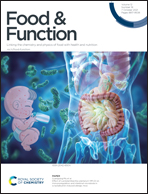Isorhamnetin attenuates high-fat and high-fructose diet induced cognitive impairments and neuroinflammation by mediating MAPK and NFκB signaling pathways
Abstract
Isorhamnetin (ISO), a flavonoid compound isolated from sea-buckthorn (Hippophae rhamnoides L.) fruit, has anti-inflammatory effects. However, the effects of ISO on neuroinflammation and cognitive function are still unclear. The purpose of this study was to evaluate the protective effect of ISO on cognitive impairment in obese mice induced by a high-fat and high fructose diet (HFFD). It has been found that oral administration of ISO (0.03% w/w and 0.06% w/w) for 14 weeks significantly reduced the body weight, food intake, liver weight, liver lipid level, and serum lipid level of HFFD-fed mice. ISO can also significantly prevent HFFD-induced neuronal working, spatial, and long-term memory impairment. Notably, the ISO treatment activated the CREB/BDNF pathway and increased neurotrophic factors in the brains of mice. Furthermore, ISO inhibited HFFD-induced microglial overactivation and down-regulated inflammatory cytokines in both serum and the brain. It can also inhibit the expression of p-JNK, p-p38, and p-NFκB protein in the mouse brain. In conclusion, these results indicated that ISO mitigated HFFD-induced cognitive impairments by inhibiting the MAPK and NFκB signaling pathways, suggesting that ISO might be a plausible nutritional intervention for metabolic syndrome-related cognitive complications.



 Please wait while we load your content...
Please wait while we load your content...